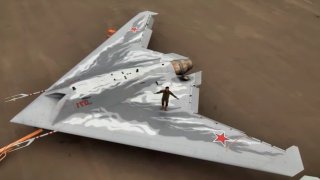S-70 Okhotnik-B: 5 Reasons NATO Hates Russia's New Stealth Drone
While it could still be years before it formally enters service, there are many reasons why Russia's S-70 Okhotnik-B stealth drone should be seen as a threat to NATO.
Five Reasons Russia's S-70 Stealth Drone Could be a Threat to NATO - It was two years ago, in December 2021 that Russia rolled out the first flight prototype of its Sukhoi S-70 Okhotnik-B – Russian for Hunter – stealth drone. The unmanned aerial vehicle (UAV) is being developed by Sukhoi and the Russian Aircraft Corporation MiG as part of a sixth-generation aircraft project.

It is based on the MiG-designed Mikoyan Skat, while it encompasses some technologies of the fifth-generation Sukhoi Su-57 (NATO reporting name "Felon") fighter. The Okhotnik heavy attack drone performed its debut flight on August 3, 2019. That flight lasted over 20 minutes under an operator's control.
It was further employed in a series of test flights earlier this year, which served to dispel myths that the stealth-heavy unmanned combat aerial vehicle (UCAV) was little more than vaporware based on a sole prototype.
S-70 Stealth Drone: 5 Reasons NATO Should Be Worried
While it could still be years before it formally enters service, there are many reasons why it should be seen as a threat to NATO.
A Drone Wingman
The Okhotnik is in the same class of drones as the Dassault nEUROn and Boeing Loyal Wingman, which are now being developed to act to augment the capabilities of manned aircraft, notably fifth-generation and even sixth-generation stealth fighters. Such UCAV could also significantly extend the sensor and weapons range of manned aircraft.
The 20-ton Sukhoi S-70 Okhotnik drone is powered by an AL-31 turbojet engine – the same used on the Sukhoi Su-27 fighter – while it can reach a top speed of 1,000 kilometers per hour (621 miles per hour), with a range of 6,000 km (3,728 miles). It is equipped with electro-optical targeting and radio, as well as other types of reconnaissance equipment. It has a pair of internal bays that can carry up to 2.8 tons of weapons.
It Will Enhance the Capabilities of Russia's Manned Aircraft
In its maiden joint flight with a Su-57 fighter, the Okhotnik drone operated in automated mode in its full configuration, entering its aerial combat alert area. The Okhotnik was able to expand the fighter's radar field and issue target acquisition data for employing air-launched weapons.
Russian defense contractor Rostec has highlighted how an artificial intelligence (AI) data link enables the Loyal Wingman capability between the S-70 and Su-57 fighter. AI-based technology could enable noise-immune coding through the use of parallel channels Rostec has claimed. It could further provide simultaneous transmission of data in all directions including air-to-ground or air-to-air, while increasing the range of transmitted data.
The Su-57 already is equipped with what the Kremlin has described as a "second pilot," and the S-70 could potentially provide the manned operator with enhanced situational awareness and ability to target a larger number of adversaries.
S-70: It is Truly Stealthy
Though the exact capabilities of the Su-57 remain questionable – with some Western analysts suggesting it is really little more than an advanced fourth-generation aircraft – the S-70 Okhotnik could truly be a stealthy hunter.
The Okhotnik's design is based on the flying-wing scheme and incorporates use of composite materials and stealth coatings, making the drone low-observable in flight
Tests Continue, But Progress is Being Made
It was in July that an S-70 was spotted flying in formation with a MiG-29 (NATO reporting name Fulcrum) fighter. A video that has circulated on social media purports to show the flying wing-shaped drone flying ahead of the Russian fighter – but neither the location nor the date of the video has been confirmed.
This would be just one of a handful of flights involving the S-70. The UCAV conducted its debut flight on August 3, 2019, which lasted slightly more than 20 minutes under an operator's control. Less than two months later, the drone took part in a second test flight that lasted more than 30 minutes, where the drone accompanied a Sukhoi Su-57 fifth-generation fighter jet. During that particular flight, the drone maneuvered in the air in automated mode at an altitude of around 1,600 meters.
It Can Fly, Can Russia Build It?
As previously reported, Russia has struggled to acquire the computer chips and other advanced components for much of its military equipment – and the problem was reportedly so bad earlier this year that microchips from refrigerators and dishwashers were repurposed and used in some tanks and armored vehicles.
The advanced artificial intelligence (AI) that is required with such a drone is significantly more advanced than what Russia may currently be able to produce domestically. However, Russia has sought to find ways around the sanctions and will continue to do so.
As previously reported, Russia is now coordinating with Iran on the development of a UAV factory outside of Moscow. While the Kremlin will continue to lean on its rogue ally Tehran to support its war efforts against Ukraine, it is simultaneously building up its homegrown drone capabilities.
Though could still be years before the S-70 enters service, it is still a weapon that should be seen as a potential threat to Western aircraft. Even a few S-70s could be hunters that should be seen as quite deadly.
Author Experience and Expertise
Peter Suciu is a Michigan-based writer. He has contributed to more than four dozen magazines, newspapers, and websites with over 3,200 published pieces over a twenty-year career in journalism. He regularly writes about military hardware, firearms history, cybersecurity, politics, and international affairs. Peter is also a Contributing Writer for Forbes and Clearance Jobs. You can follow him on Twitter: @PeterSuciu.
All images are Creative Commons.


